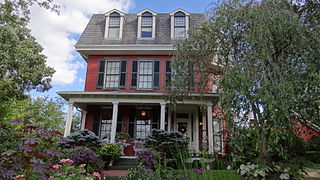
The Alexander Wade House is a historic house at 256 Prairie Street in Morgantown, West Virginia. Built in 1860, it was the home of educator Alexander Wade (1832-1904) from 1872 until his death. Wade is credited with developing a system of grade promotional exams and graduations that was widely adopted in the late 19th century. The house was declared a U.S. National Historic Landmark in 1965.

Walters House, also as known as the Walters Residence, is a historic home located in Morgantown, Monongalia County, West Virginia. It was built about 1900-1901, and is a brick Queen Anne style brick dwelling. It features a three-story tower in the southeast corner topped with a wrought-iron balustrade. The architect is unknown. It was a single family home until 1931, after which it was a boarding house, fraternity house, home of the University Christian Council, and law offices. It is currently the location of the Morgantown Chabad Jewish Center. It was listed on the National Register of Historic Places in 1983. It is located in the Downtown Morgantown Historic District, listed in 1996.

Women's Christian Temperance Union Community Building, also known as the WCTU Building, is a historic building at 160 Fayette Street in Morgantown, Monongalia County, West Virginia. It was built in 1922 by the Woman's Christian Temperance Union, and is a detached, brick, four-story plus basement structure in the Classical Revival style. It features a smooth-cut stone cornice topped by a balustrade. The interior has a two-level basement that houses a large gymnasium. The building also houses office space, meeting rooms, private apartments, and recreational facilities.

Dering Building is a historic commercial building located at Morgantown, Monongalia County, West Virginia. It was designed by noted Morgantown architect Elmer F. Jacobs and built in 1896. It is a three-story Romanesque Revival style brick building. It has a rectangular plan, a flat roof, separate store fronts, and recessed portico entrances. It features a pediment above the flat roof with a rising sun motif and the date of construction inscribed in the center.
Elmer F. Jacobs was a Morgantown, West Virginia-based architect.

Rogers House is a historic home located at Morgantown, Monongalia County, West Virginia. It was originally built about 1857 and is one of the last remaining residences from this time period in downtown Morgantown. The building is a two-story, five bay brick and wood frame dwelling in the Classical Revival style. The original section of the house is in brick, whereas the addition, designed by noted Morgantown architect Elmer F. Jacobs and built in 1905-1906 is wood frame. Jacobs is also responsible for the interior design. It sits on a rough-faced coursed ashlar stone foundation. It features a front porch with four sets of triple wooden, Tuscan order columns. It was the home of the Rogers family, pioneer settlers of Morgantown. It has been the home of West Virginia University's Campus Ministry Center since 1984. It was listed on the National Register of Historic Places in 1984. It is located in the Downtown Morgantown Historic District, listed in 1996.
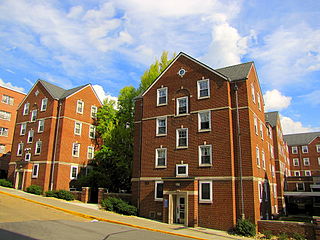
Men's Hall, also known as Boreman Hall South, is a historic dormitory associated with the West Virginia University and located at Morgantown, Monongalia County, West Virginia. It was built in 1935, and is a five-story, "E"-shaped red brick building with Classical Revival detailing. It sits on a reinforced concrete foundation and has a slate covered gable roof. When documented in 1989, it housed 350 students in 329 rooms. It was the first dormitory built for men on campus. Its construction was funded in part by the Works Progress Administration. During World War II, it was used as an Air Force barracks.
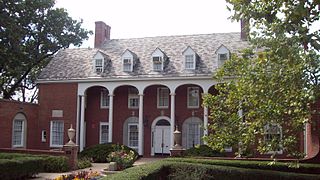
Elizabeth Moore Hall is a historic women's physical education building associated with West Virginia University and located in Morgantown, Monongalia County, West Virginia. It was built between 1926 and 1928, and is a three-story, red brick building with Georgian Revival detailing. An addition was completed in 1962. It has a slate covered gable roof. The front facade features five arches supported by six Doric order columns. It also has balconies with cast iron balustrades. The building is named for Elizabeth Moore, principal of Woodburn Female Seminary from 1865 to 1866.

Oglebay Hall is a historic classroom building associated with the West Virginia University and located at Morgantown, Monongalia County, West Virginia. It was built in 1918, and is a three-story, brick and concrete building with Classical Revival detailing. The front facade features four Doric order columns that support a pediment with a false, concrete railing and entablature with the building's name. It also has balconies with cast iron balustrades. It originally housed the university's College of Agriculture and represents the university's heritage as a land-grant institution. The building is named for industrialist and philanthropist Earl W. Oglebay, whose house at Wheeling, West Virginia is known as the Oglebay Mansion Museum.
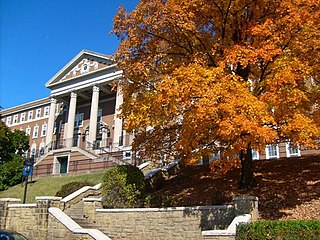
Stalnaker Hall, also known as Woman's Hall, is a historic dormitory building associated with the West Virginia University, located in Morgantown, Monongalia County, West Virginia. Constructed in 1918, it is a three-story, brick building on a high basement, with Classical Revival detailing. Two-story additions were built between 1935 and 1939. The front facade features four Corinthian order columns that support a pediment with decorative concrete work. It was named for Elizabeth Stalnaker, professor of philosophy and psychology in the early 20th century.

Woodburn Circle, also known as W.V.U. Quadrangle, is part of the downtown campus of West Virginia University; it's located at Morgantown, Monongalia County, West Virginia. The circle, in reality a quadrangle grouped around an oval path, is a historic and distinctive architectural assembly of three collegiate buildings, which evolved in the late nineteenth century. In chronological order these are Martin Hall, Woodburn Hall and Chitwood Hall. However, it's the largest of the buildings, Woodburn Hall, that is best known and a symbol of the university.

Fourth Ward School, also known as the Wiles Hill School, is a historic school building located at Morgantown, Monongalia County, West Virginia. It consists of the original 1910 school building with two historic additions from 1939 and 1952, and the 1983 gymnasium building. It is a two-story, red brick, Romanesque Revival building on a raised basement and water table of ashlar sandstone. The 1939 rear addition was built as a Public Works Administration project and has plain Art Deco style trim The 1939 addition contains a stage and an auditorium / cafeteria.
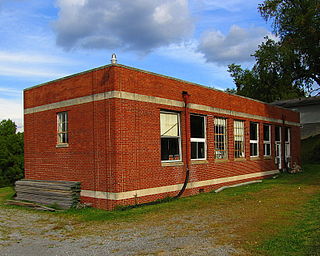
Second Ward Negro Elementary School, also known as the Second Ward Annex, is a historic school building located at Morgantown, Monongalia County, West Virginia. It was built in 1938–1939, and is a one-story, plus basement, "T"-shaped brick building in the Art Deco style. It sits on a sandstone foundation. Funds for the building's construction were provided by the Works Progress Administration. It functioned as a school for African American students and a community center until the end of segregation in 1954. The building reopened as a school annex and Instructional Materials Center in the 1960s, but ceased being used as a school in 1993.
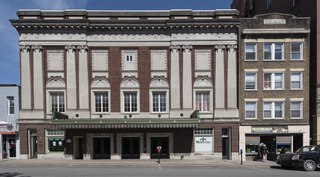
Metropolitan Theatre is a historic theater building located at Morgantown, Monongalia County, West Virginia. It opened July 24, 1924, two-and-a-half years after construction began, and consists of a single floor auditorium with balcony. The building measures 72 feet by 143 feet, and has two storefronts on the ground floor and a pool room in the basement. The front facade features fluted concrete Ionic order pilasters with egg-and-dart detail in the Classical Revival style. The theater continues to provide a home for the city's best live entertainment.

Monongalia County Courthouse is a historic courthouse building located in Morgantown, Monongalia County, West Virginia. The courthouse was erected in 1784 with the current structure built in 1891. This Romanesque style building consists of a two-story building with a basement, five-story clock tower and a three-story South tower. The building measures at 99’ by 83’ by 99’ by 76’ with the first story at fifteen feet high and the second story at twenty-two feet high. The distinctive central clock tower has a pyramidal roof, four doomed buttresses, stone molds over the four clocks and tower windows, arcade belfry, and quatrefoil design with the building date. The original northern facade was covered by an addition built in 1925 with another addition built in 1975. Connected to the courthouse is a two-story Italianate style jailhouse built in 1881.

Kincaid and Arnett Feed and Flour Building is a historic warehouse building located at Morgantown, Monongalia County, West Virginia. It was built between 1904 and 1906, and is a three-story, vernacular brick warehouse located along the banks of the Monongahela River. It is trapezoid shaped and has a prominent concrete-block loading dock with overhead canopy. Kincaid and Arnett functioned as a prosperous wholesale and retail grain dealership and brokerage until they sold the property to Morgantown Feed and Flour Corporation in February 1921.

D.I.B. Anderson Farm, also known as the D.I.B. Anderson House and Chauncey M. Price House, is a historic home located in Morgantown, Monongalia County, West Virginia. It was built about 1866, and is a two-story, asymmetrical brick farmhouse in a vernacular Italianate style. It features a one-story front porch and a second story "sleeping porch." Also on the property is a contributing ice house and summer kitchen building built of hand made bricks, and a cut sandstone well house.

Seneca Glass Company Building, now called Seneca Center, is a historic glass factory located at Morgantown, Monongalia County, West Virginia. It was built by the Seneca Glass Company in 1896–1897, and is an industrial complex of work areas, all connected by doors, passageways, or bridges. A fire in 1902, destroyed much of the interior of the original brick part of the complex. After the fire, Elmer F. Jacobs designed the new two-story replacement, a new Needle Etching Room in a separate building connected by a bridge, and the reconstruction of the Grinding, Glazing, and Cutting areas. A large addition was built in 1947. The building features a conical brick stack that projects 36 feet above the roofline of the Furnace / Blowing Room. The complex was the home of one of the finest hand-blown, hand-cut and etched, lead glass factories in the world. After the factory closed in 1983, it was adapted for commercial use.

The Downtown Morgantown Historic District is a federally designated historic district in Morgantown, Monongalia County, West Virginia. The district, encompassing approximately 75 acres, has 122 contributing buildings and 2 contributing sites including commercial and public buildings, residences, and churches. The district has been listed on the National Register of Historic Places since May 2, 1996. Ten of the contributing buildings are listed separately on the National Register of Historic Places. Significant structures located within the historic district are the Monongalia County Courthouse, the Metropolitan Theater, and the Old Morgantown Post Office.

Greenmont Historic District is a national historic district located at Morgantown, Monongalia County, West Virginia. The district includes 409 contributing buildings, 4 contributing structures, and 2 contributing objects in a primarily residential area of the Greenmount neighborhood of Morgantown. Most of the dwellings were built between 1901 and 1925 and are of frame construction with brick or wood facades, one- to 2 1/2 stories high with gable fronts. Notable buildings include the Reformation Orthodox Presbyterian Church. Also in the district are the separately listed Kern's Fort, and Hackney House.






















